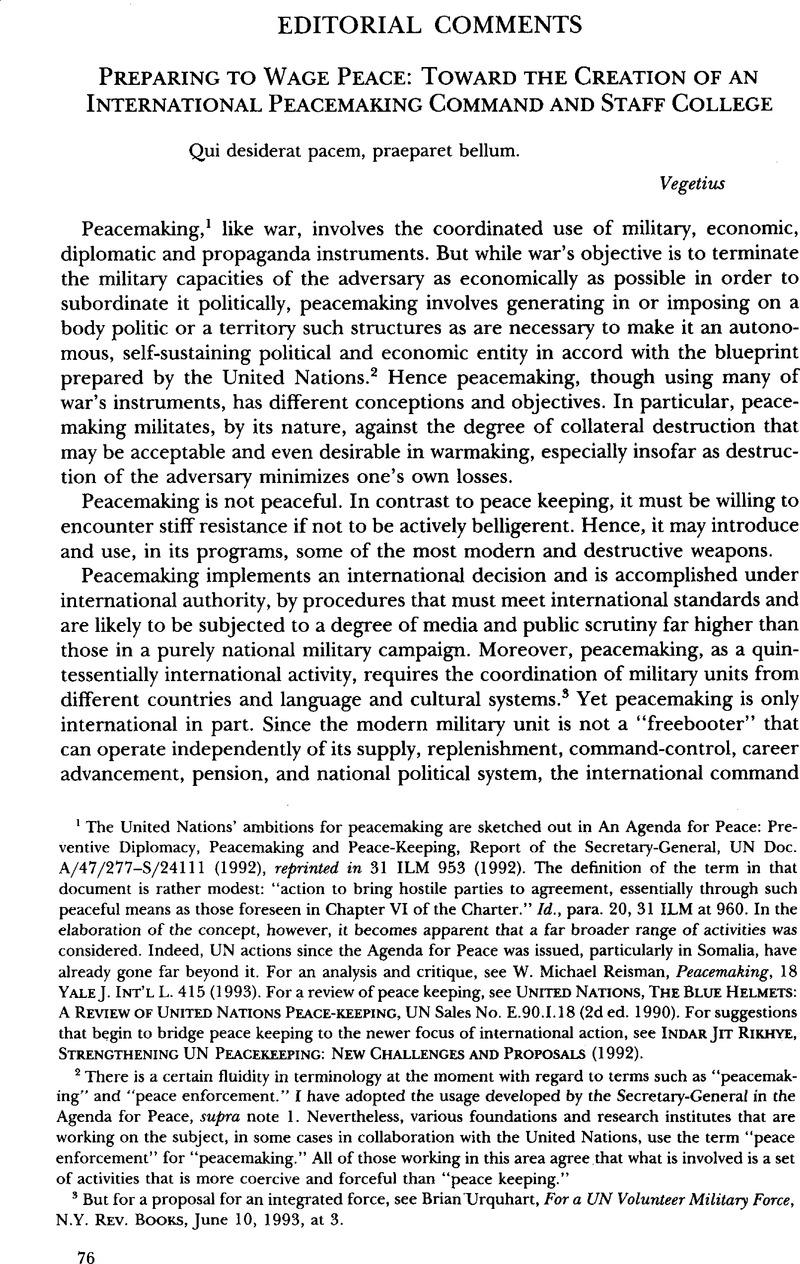Article contents
Preparing to Wage Peace: Toward the Creation of an International Peacemaking Command and Staff College
Published online by Cambridge University Press: 27 February 2017
Abstract

- Type
- Editorial Comments
- Information
- Copyright
- Copyright © American Society of International Law 1994
References
1 The United Nations’ ambitions for peacemaking are sketched out in An Agenda for Peace: Preventive Diplomacy, Peacemaking and Peace-Keeping, Report of the Secretary-General, UN Doc. A/47/277-S/24111 (1992), reprinted in 31 ILM 953 (1992). The definition of the term in that document is rather modest: “action to bring hostile parties to agreement, essentially through such peaceful means as those foreseen in Chapter VI of the Charter.” Id., para. 20, 31 ILM at 960. In the elaboration of the concept, however, it becomes apparent that a far broader range of activities was considered. Indeed, UN actions since the Agenda for Peace was issued, particularly in Somalia, have already gone far beyond it. For an analysis and critique, see W. Michael Reisman, Peacemaking, 18 Yale J. Int’l L. 415 (1993). For a review of peace keeping, see United Nations, The Blue Helmets: A Review of United Nations Peace-Keeping, UN Sales No. E.90.I.18 (2d ed. 1990). For suggestions that begin to bridge peace keeping to the newer focus of international action, see Indar Jit Rlkhye, Strengthening UN Peacekeeping: New Challenges and Proposals (1992).
2 There is a certain fluidity in terminology at the moment with regard to terms such as “peacemaking” and “peace enforcement.” I have adopted the usage developed by the Secretary-General in the Agenda for Peace, supra note 1. Nevertheless, various foundations and research institutes that are working on the subject, in some cases in collaboration with the United Nations, use the term “peace enforcement” for “peacemaking.” All of those working in this area agree that what is involved is a set of activities that is more coercive and forceful than “peace keeping.”
3 But for a proposal for an integrated force, see Brian Urquhart, For a UN Volunteer Military Force, N.Y. Rev. Books, June 10, 1993, at 3.
4 There are, however, training materials for peace keeping. Several states have developed manuals for those involved in traditional peace-keeping training. Perhaps the best known are the Nordic manuals. Joint Nordic Committee for Military U.N. Matters, Nordic U.N. Tactical Manuals (1992).
The first of the two Nordic volumes focuses on basic training for troops involved in UN operations. The second volume outlines the responsibilities of commanders in the field. Sweden, Denmark, Norway and Finland use these manuals as the basis for joint training programs. These programs train command, communications, and logistical personnel in the operational procedures of a UN assignment.
An outstanding example and possible model for peacemaking is International Peace Academy, Peacekeeper’s Handbook (1984), which was compiled and edited by Brigadier Michael N. Harbottle (ret.) of the United Kingdom. It is a vade mecum for personnel assigned to UN peace keeping, which it defines as “using multinational military, police and civilian personnel to restore and maintain peace.” Id. at 7. Moreover, it provides, in the annexes to chapter IX, a syllabus and staff course outline. But the activities contemplated are, in fact, more limited and much more restrained than those likely to be used in peacemaking. See especially id., ch. V.
Canada, with significant experience in peace-keeping operations, has developed its own training materials. They are issued by the Ministry of National Defense and used in instructing Canadian troops. The British Army has included in its manual a section explaining the required conduct of troops in UN peace-keeping operations. 5 Chief of the General Staff, Field Manual, pt. 1 (1988).
In addition to these manuals, the UN training staff is developing its own guide for troops. A second draft was recently completed on A Peacekeeping Training Manual. The training staff also has completed the first draft of a curriculum development report that would be used while conducting training of higher-level personnel in war colleges. Though these training materials are focused on peacekeeping operations, they also discuss more extensive military operations that might be carried out by UN forces.
5 There is currently no curriculum being developed which is geared to the unique needs of peacemaking or peace enforcement operations. However, some ad hoc training is developing. For instance, the United States has reportedly instructed its troops on rules of engagement for missions that go beyond traditional peace keeping. Telephone interview with Maj. Gen. John O. B. Sewall (U.S. Army, ret.), Senior Fellow, Institute for National Strategic Studies, National Defense University (Oct. 15, 1993).
The special training needs of peace enforcement missions have prompted discussion in a number of military and academic settings. Among the groups addressing the issue is the Henry Stimson Center in Washington, D.C. As part of a larger investigation of future training needs for UN operations, the Center is undertaking a detailed investigation into the special curricular and training needs of peace enforcement missions. Telephone interview with Matthew Vaccaro, Research Associate, Henry L. Stimson Center (Oct. 4, 1993).
- 1
- Cited by




